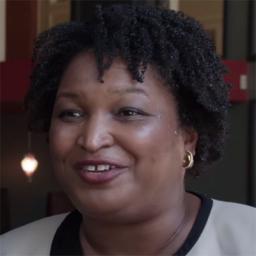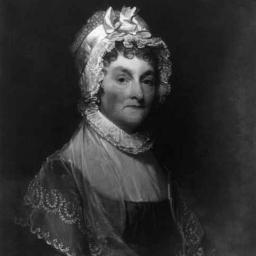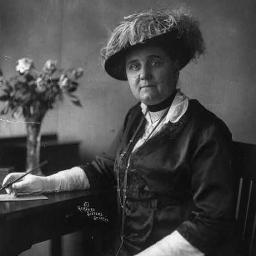Alice Paul
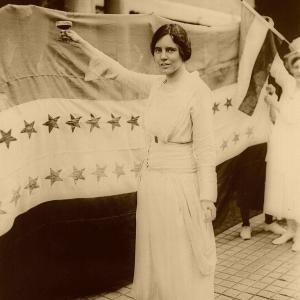
Early Life
Born on January 11, 1885, in Mount Laurel, New Jersey, Paul was the oldest of four children of Tracie Parry and William Paul, a wealthy Quaker businessman (Lunardini, 2013). Paul’s parents embraced gender equality, education for women, and working to improve society. Parry was an avid suffragist and attended women’s suffrage meetings hosted by their neighbors with a young Paul alongside her. Paul’s parents raised her in the Hicksite Quaker tradition that supported gender equality (Lunardini, 2013; University of Pennsylvania, 2020). William Paul bought 117 acres in New Jersey to develop it into a working farm he later named Paulsdale. While he hired people to work the farm, all four Paul children were expected to work on the farm to reinforce the Quaker teachings of the value of work and to be close to nature (Lunardini, 2013).

Above: Alice Paul Graduate Portrait (University of Pennsylvania)
Education and England
Paul attended Swarthmore College, a Quaker school cofounded by her grandfather and abolitionist and suffragist Lucretia Mott, where she graduated with a biology degree in 1905. Paul chose biology as a course of study to expand her knowledge base and was quoted as saying, “This is the only way I will ever learn about [science]” (Lunardini, 2013). Following her time at Swarthmore, she attended the New York School of Philanthropy (now Columbia University) and received a Master of Arts degree in sociology in 1907. Paul began pursuing a PhD at the University of Pennsylvania. Still, she put the program on hold upon learning of her nomination from an unknown party for a fellowship at the Quaker school in Woodbrooke, England (Lunardini, 2013). The Woodbrooke School allowed Paul to explore topics she loved, such as economics and sociology, and it was here that Paul took additional classes at the University of Birmingham (Lunardini, 2013). The classes at the University of Birmingham proved to be the defining moment in Paul’s life, when she experienced a lecture from prominent activist Christabel Pankhurst (Lunardini, 2013). This event marked Paul’s first encounter with the Women’s Social and Political Union (WSPU) (Winslow, 2025). Not long after, Paul met fellow American Lucy Burns and became fast friends (Winslow, 2025). Both Paul and Burns joined the efforts of WSPU, where the two learned of militant protest tactics, including picketing and hunger strikes (Winslow, 2023). Paul returned to the United States to continue her program at the University of Pennsylvania and graduated with her PhD in 1912.
Early Activism
While in England, Paul met American Lucy Burns and joined the women’s suffrage efforts there. Paul and Burns learned militant protest tactics, including picketing and hunger strikes. While working with the WSPU, Paul was imprisoned and experienced the trauma of force feeding a total of 55 times during one prison term (Zahniser & Fry, 2014). After recovering from her imprisonment, she gave a farewell speech to her comrades in the WSPU on January 3, 1910, to justify her decision to return to America, stating her intentions to continue the work of fighting for women’s equality (Zahniser & Fry, 2015). I That same year, Paul joined the National American Woman Suffrage Association (NAWSA). Within a week of coming home to Pennsylvania, she began to lecture as a suffragist (Zahniser & Fry, 2015). Paul continued to work with the Pennsylvania chapter of NAWSA by organizing open-air events and lectures for nearly two years before she was offered a position on the NAWSA national committee in December of 1912.
The March 1913 Suffrage Procession
Paul now led the Congressional Committee of NAWSA and quickly made her mark with unique determination and talent for organizing fellow suffragists (Cahill, 2015; Hawranick et al., 2008). She recruited her friend Burns to aid her in organizing a grand procession using the tactics she learned from her British counterparts (Zahniser & Fry, 2015). Her first—and the largest—was in Washington, DC, on March 3, 1913, the day before President-elect Woodrow Wilson’s inauguration (Cahill, 2015).
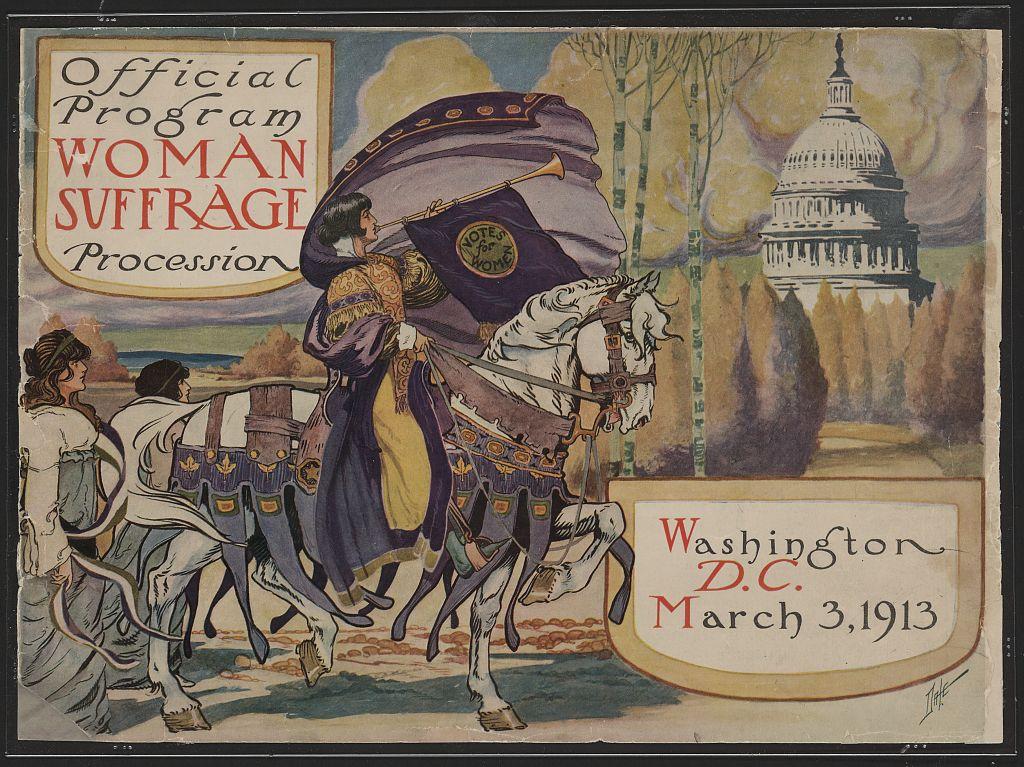
Above: Dale & League of Women Voters, (1913), https://www.loc.gov/item/94507639/
Approximately eight thousand women marched in procession with 26 floats, nine different bands, five calvary units complete with six chariots, and floats (Hawranick et al., 2008). The parade comprised suffragists from academia, professional organizations, and representatives of state and local governments in a sea of purple and gold (Hawranick et al., 2008). The parade went down Pennsylvania Avenue from the Capitol to the White House, which followed the same route the inaugural parade would follow the next day. Upon arriving in Washington, Wilson inquired why the streets were empty, and an aide informed him that they were all “watching the suffragist parade” (Hawranick et al., 2008, p. 190). Nearly half a million spectators watched the procession, mixed with both supporters and anti-suffragists.
The procession, however, would not remain a peaceful display for the fight for suffrage as the crowds began to flood the street and block the procession from continuing (Cahill, 2015). Many of the suffragists in the procession suffered acts of violence ranging from being tripped to physical assault by members of the crowd (Harvey, 2018). Police presence during the parade was scant and suffragists reported that there was no aid from officers. Some suffragists recollected being scolded by the few police that were present that “There would be nothing like this happen if you would stay at home” (Harvey, 2018, para. 1). The mob violence reflects the cultural tone that granting women suffrage was appalling to many Americans (Cahill, 2015). Nearly 300 hundred women were harmed by the mob violence, but the procession ultimately achieved Paul’s goal of dominating the newspaper the next day over Wilson’s inauguration. Almost two weeks later, on March 17, Paul and other suffragists met with Wilson, who said it was not yet time for an amendment to the Constitution.
The Silent Sentinels and the National Women’s Party
On April 7, Paul organized a demonstration and founded the Congressional Union for Woman Suffrage to focus on lobbying Congress. This was in contrast to NAWSA’s focus on state-by-state campaigns, but Paul preferred to lobby Congress directly for a constitutional amendment. These differences led Paul and others to split with NAWSA and form the National Woman's Party (Southard, 2007).
In January 1917, Paul and over 1,000 “Silent Sentinels” began eighteen months of picketing the White House, standing at the gates dressed in hues of purple and gold with such signs as, “Mr. President, how long must women wait for liberty?” (Southard, 2007). The silence the women maintained was a “gendered political performance” to reflect the systemic oppression they faced due to disenfranchisement (Southard, 2008, p. 405). They endured verbal and physical attacks from spectators, which increased after the US entered World War I. Instead of protecting the women’s right to free speech and peaceful assembly, the police arrested Paul and 33 other suffrage picketers on the flimsy charge of obstructing traffic. Paul was sentenced to the Occoquan Workhouse for seven months, where she organized a hunger strike in protest. It was there at the Occoquan Workhouse that Paul and her fellow suffragists endured the immense physical violence at the hands of their jailors in what later came to be known as the Night of Terror (Carter Olson, 2021). At the workhouse, Paul once again suffered the trauma of forced feeding (Carter Olson, 2012). The treatment the woman faced in the workhouse was leaked to newspapers with accounts of her treatment and, in turn, garnered public sympathy and support for suffrage despite public sentiment that criticism of the government during World War I was unpatriotic (Winslow, n.d.).
The Equal Rights Amendment
By 1918, Wilson ordered all suffragists be released and later announced his support for suffrage. On January 10, 1918, the House of Representatives voted in favor of the suffrage amendment with an approval from the Senate following in June of 1919. It took another year for 36 states to ratify the amendment on August 26th of 1920 (Winslow, n.d.) While it is impossible to truly understand what was going on through Pau’s mind as she stood on the balcony with a victory flag, it is not a stretch to assert she was planning her next steps in advocacy for women’s equality in America (Cahill, 2015).
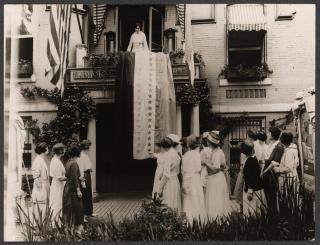
Above: National Photo Co. (1920), https://www.loc.gov/item/mnwp000256/
Despite this monumental win, Paul’s advocacy was not done. In 1921, Paul and her colleague, Crystal Eastman, drafted the Lucretia Mott Equal Rights Amendment (later known as the Equal Rights Amendment), which read,
“Men and women shall have equal rights throughout the United States and every place subject to its jurisdiction. Congress shall have the power to enforce this article by appropriate legislation.”
The Equal Rights Amendment sought to guarantee women constitutional protection from discrimination. However, other women’s rights advocates fiercely opposed the amendment at the time, citing that it would undo the work of other legislation pertaining to issues such as rights within the workforce (Winslow, n.d.). Paul spent her life advocating for this and other women’s issues and passed away in her home state of New Jersey. The ERA was ratified by 35 states in the 1970s, but by the 1982 deadline, three states were short of the 38 needed to become a constitutional amendment.
Legacy
Paul spent her life advocating for this and other women’s issues and passed away in her birthplace in New Jersey. Her legacy endures through her work as a suffragist leader and women’s rights activist. Paul’s legacy continues to be honored through modern initiatives and organizations. The Alice Paul Center for Gender Justice, based in her childhood home of Paulsdale, is an educational center promoting leadership development and civic engagement for women and girls. Her role in the fight for the Equal Rights Amendment remains a continuing fight in contemporary equal rights efforts. Even though the ERA was ratified by 35 states in the 1970s, by the 1982 deadline, it was three states short of the 38 needed to become a constitutional amendment. ERA was reintroduced into the 117th Congress and marks the legacy of Paul’s work as an activist for women in the United States.
 Educator Notes
Educator Notes
Essential Questions
-
How did Alice Paul's Quaker upbringing and education influence her leadership in the women’s suffrage movement?
-
What role did militant protest tactics play in the fight for women's suffrage, and how did Alice Paul's experiences in England shape her strategies in the United States?
-
In what ways did Alice Paul’s advocacy extend beyond the 19th Amendment, and how does her legacy continue to influence gender equality movements today?
Primary Source Analysis Strategies
Observe, Reflect, Question (ORQ) Strategy
Observe: Students examine primary sources, such as photographs of the 1913 suffrage parade or the Silent Sentinels picketing the White House, noting key details (who, what, where, when).
Reflect: They consider the significance of the images—what emotions or messages do they convey? How do they reflect the cultural and political climate of the time?
Question: Students generate questions about the source, such as the reactions of the public or government, and research to find answers.
Connecting Past to Present Strategy
Students analyze a speech or newspaper article about Alice Paul’s activism and compare it to modern advocacy for gender equality, such as the continued fight for the Equal Rights Amendment.
They identify themes of protest, resistance, and policy change, drawing parallels between past and present movements.
Lesson Plans
Related Biographies
Cahill, B. (2015). Alice Paul, the National Woman’s Party and the Vote : The first civil rights struggle of the 20th Century. McFarland & Company, Incorporated Publishers.
Carter Olson, C. S. (2021). “To Ask Freedom for Women”: The Night of Terror and Public Memory. Journalism & Mass Communication Quarterly, 98(1), 179–199. https://doi.org/10.1177/1077699020927118
Harvey, S. (2018). Marching for the vote: Remembering the Woman Suffrage Parade of 1913. In Library of Congress. (2001). American Women: A Library of Congress Guide for the Study of Women’s History and Culture in the United States. https://guides.loc.gov/american-women-essays/marching-for-the-vote
National Photo Co, W. (1920) When Tennessee the 36th state ratified, Alice Paul, National Chairman of the Woman's Party, unfurled the ratification banner from Suffrage headquarters. Tennessee United States Washington D.C, 1920. [Photograph] Retrieved from the Library of Congress, https://www.loc.gov/item/mnwp000256/.
Hawranick, S., Doris, J. M., & Daugherty, R. (2008). Alice Paul: Activist, advocate, and one of ours. Affilia, 23(2), 190–196. https://doi.org/10.1177/0886109908314332
Lunardini, C. A. (2013). Alice Paul : equality for women (1st ed.). Westview Press. https://doi.org/10.4324/9780429502392
Southard, B. A. S. (2007). Militancy, power, and identity: The Silent Sentinels as women fighting for political voice. Rhetoric & Public Affairs, 10(3), 399–417. https://doi.org/10.1353/rap.2008.0003
University of Pennsylvania. (2020). Penn alumna Alice Paul: Feminist, suffragist, political strategist. University of Pennsylvania Almanac, 66(27). https://almanac.upenn.edu/articles/penn-alumna-alice-paul-feminist-suffragist-political-strategist
Winslow, B. (n.d.) Alice Paul, suffrage militant. The Gilder Lerhman Institute of American History. https://www.gilderlehrman.org/history-resources/essays/alice-paul-suffrage-militant
Zahniser, J. D., & Fry, A. R. (2014). Alice Paul claiming power. Oxford University Press.
MLA - Michals, Debra. "Alice Paul." National Women's History Museum. National Women's History Museum, 2015. Date accessed.
Chicago - Michals, Debra. "Alice Paul." National Women's History Museum. 2015. www.womenshistorymuseum.org/education-resources/biographies/alice-paul.
Websites
- Connecticut Women’s Hall of Fame
-
Library of Congress, Women of Protest: Photographs from the Records of the National Woman’s Party
-
“Alice Paul: Suffragist and Agitator,” The Gilder Lehrman Institute of American History
Books
-
Butler, Amy E. Two Paths to Equality: Alice Paul and Ethel M. Smith in the Era Debate, 1921-1929. New York: State University of New York Press, 2002.
-
Haynes, Inez. The Story of the Woman's Party New York: Kraus Reprints, 1971, c1921.
-
Lunardini, Christine. From Equal Suffrage to Equal Rights: Alice Paul and the National Woman’s Party, 1910-1928. IUniverse, 2000.
-
Raum, Elizabeth. Alice Paul. Heinemann, 2004. [for ages 4-8]
-
Lunardini, Christine A. From Equal Suffrage to Equal Rights: Alice Paul and the National Woman's Party, 1910–1928. New York: New York University Press, 1986.
-
Raum, Elizabeth. Alice Paul. Chicago, IL: Heinemann Library, 2004.
Film:
-
"Iron Jawed Angels"

